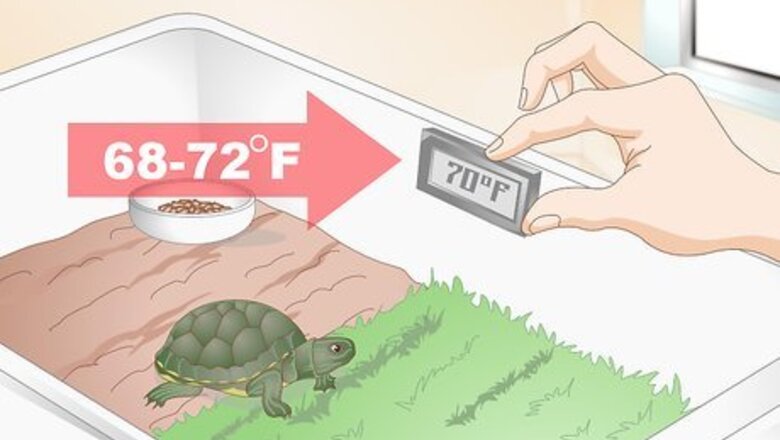
views
Determining Why Your Turtle Won't Eat
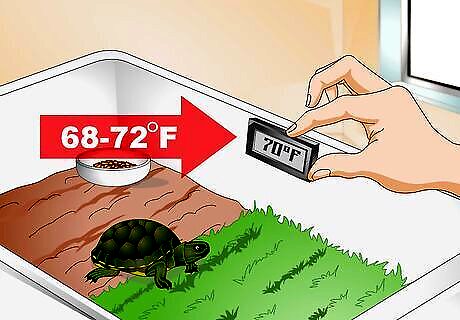
Check the temperature. Turtles are cold blooded reptiles and will not eat if the temperature is too cold. If you have an indoor box turtle, provide a warm area and a cool area. The cool area should be between 68 and 72 degrees Fahrenheit and the warm area should be 85 degrees Fahrenheit during the day. At night, the temperature can drop to between 60 and 75 degrees Fahrenheit. For aquatic turtles, the water temperature should be about 78 degrees Fahrenheit. The basking area should be between 80 and 85 degrees Fahrenheit. If your box turtle lives outside, the turtle will become too cold if the outside temperature drops below 60 degrees Fahrenheit. You may need to add a ceramic heater to your turtle's environment to get it to reach an adequate temperature. Check the temperature of your turtle environment using a thermometer and make adjustments if necessary.
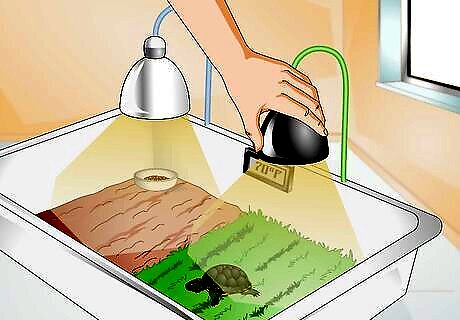
Provide more light. Your turtle also needs adequate light to have a healthy appetite. Aquatic turtles need both UVA and UVB light in their tank. Provide your turtle with 12 to 14 hours of light followed by 10 to 12 hours of darkness. Box turtles need light for at least 12 hours every day. This can be direct sunlight or a combination of a UVB bulb and an incandescent bulb. If your turtle is getting less than 12 hours of a light a day, it will probably stop eating. If you have an outside box turtle, you will need to adjust the light source with the seasons. For example, you may use more artificial lighting in the fall and winter as the days are shorter and nay not need any artificial lighting in the summer. Change out your turtle's UV bulbs every 6 months. UV lights become less effective over time.
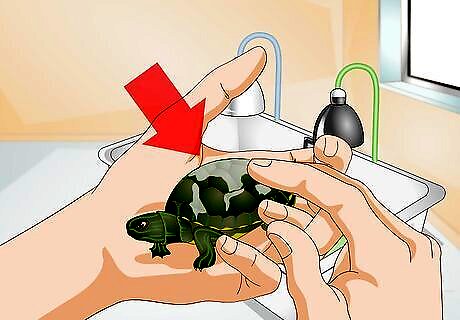
Check for signs of sickness. If your turtle is not eating and you have checked the environment, your turtle may be suffering from an illness. Stress, and illnesses such as vitamin A deficiency, constipation, respiratory infection, eye problems, or pregnancy. If your turtle is not eating, look for other symptoms to decide if your turtle is sick and needs to see a veterinarian. If your turtle has white, patchy discoloration on its shell and refuses to eat, your turtle may be suffering from vitamin A deficiency. Vitamin A deficiency is linked to respiratory infections in turtles as well. Other symptoms of a respiratory infection include wheezing, trouble breathing, sneezing, runny nose, swollen eyes, and a lack of energy. If your turtle has stopped eating and stopped going to the bathroom, your turtle may be constipated. If your turtle is having eye problems and cannot see, your turtle will not eat. Check your turtle's eyes to ensure that they are clear, free of debris, and shiny.
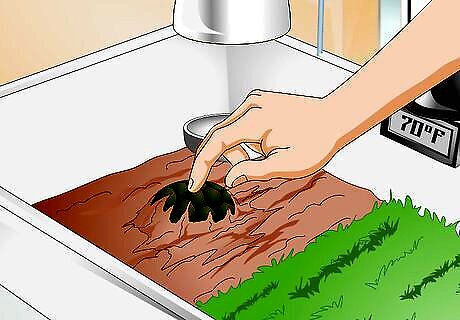
Determine if your turtle is hibernating. Asian, European, and North American turtles may hibernate for the winter season. Even if your turtle has the proper environment and plenty of food, it still may choose to hibernate. If you have checked your turtle's habitat and physical health and it still won't eat, take your turtle to the veterinarian to see if your turtle may be trying to hibernate. Hibernation puts stress on the body. Only healthy turtles should be allowed to hibernate. If your veterinarian says that it is okay for your turtle to hibernate, begin to reduce the temperature in its habitat by 2 or 3 degrees each day. This will help slow your turtle's metabolism down. Do not let the temperature drop below 50 degrees Fahrenheit. Begin to increase the temperature by a few degrees each day after 10 weeks. Continue to feed your turtle until it stops eating completely.
Enticing Your Turtle to Eat
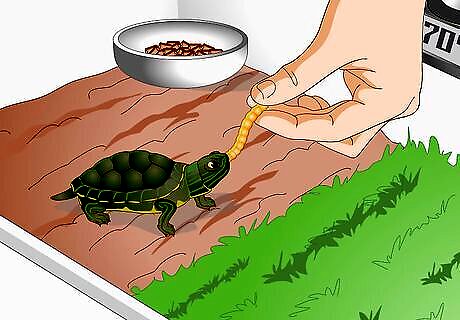
Give your turtle live food. Your turtle is attracted to movement and may prefer to eat live food such as crickets, mealworms, waxworms, earthworms, snails, slugs, or small pinky mice. Live food also has a strong odor that is attractive to your turtle. Be careful with digging up earthworms and giving them to your turtle. If the lawn has been treated with chemicals, do not give the earthworms to your turtle. It is best to buy earthworms from a bait store. Your turtle may also enjoy eating grubs, beetles, pill bugs, crayfish, flies, grasshoppers, bloodworms, and spiders.
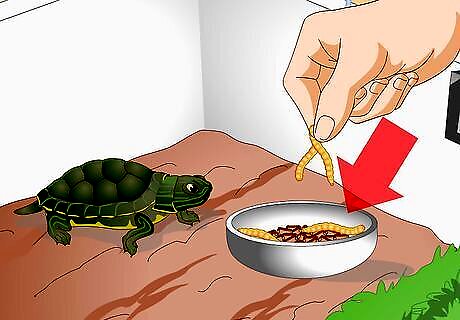
Combine pellets with other foods. Pellets or dry turtle food are a staple of many turtle's diet. Crush the pellets and mix them with some live food to get your turtle to eat. You can also soak the pellets in canned tuna water to give the pellets a stronger, more enticing smell. You can also soak the pellets in fruit juice or a non-caffeinated sport's drink to encourage your turtle to eat. If you have a box turtle, try placing this food in water as your turtle may prefer to eat under water instead of on land. Get creative with food presentation. "I had been struggling to get my turtle to eat for over a week. After reading this article, I decided to try soaking his food in tuna juice to make it more enticing. To my delight, when I put the food in his tank underwater, he gobbled it right up! Adding a little flair to the food's presentation made all the difference." - Chloe U. Investigate sudden behavioral changes. "My beloved red-eared slider that I've cared for over 16 years recently started acting very strangely - constantly trying to slip out the door, rearranging things, and refusing all her favorite foods. I became concerned that something more serious could be wrong, especially when I felt what seemed like eggs. Since she hadn't laid eggs in years, I knew these big changes in behavior after so long likely signified illness or another issue. We went off to the vet to get her checked out." - Zoe D. Confirm proper lighting. "Just a couple of days after getting my new turtle, he suddenly stopped eating. With wikiHow's advice on lighting needs, I realized he likely wasn't getting enough since he lives in my darker bedroom. After adding a heat lamp to give him more consistent light during the day, his appetite returned. Proper lighting is key!" - Madelyn R. Try food in a new environment. "I discovered my turtle had stopped eating but couldn't figure out why, with his habitat conditions all seemingly okay. This article advised that sometimes feeding location makes a difference, so I tried offering his food both in and out of the water. It worked — he ate with gusto when given his meal underwater! Switching up location can prompt eating." - Madison S. We want to hear from you! Advice from our readers makes our articles better. If you have a story you’d like to share, tell us here.
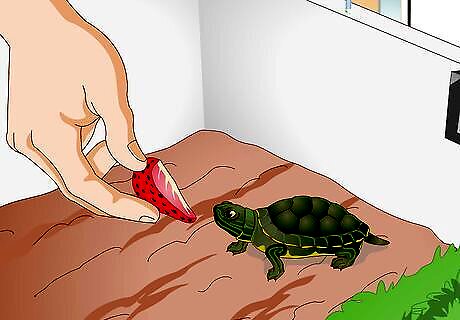
Provide brightly colored food. Your turtle is attracted to brightly colored food. Offer your turtle strawberries, tomatoes, papaya, mango, watermelon, rose petals, or other brightly colored vegetables and fruits. Fruit should not be a staple in the diet of your turtle, but can be used to get your turtle to begin eating. You can combine brightly colored food with live food to get even better results. The bright color and strong odor may be doubly attractive. Vegetables are more important for your turtle than fruit. Try soaking the vegetables in tuna water to get your turtle to eat them.
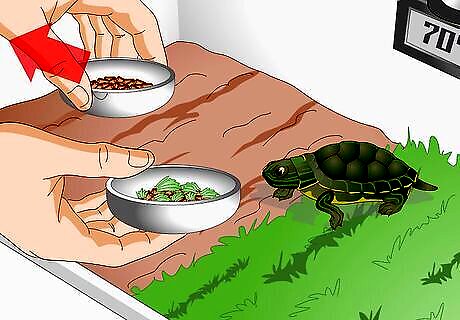
Switch up the diet. Your turtle may not be eating simply because it does not like the food that you have been offering. For example, you may finely chop vegetables and pellets and dip them in bloodworm juice one day and then provide mangoes and pellets in tuna water the next day. Your turtle has preferences that you must learn. It may be helpful to keep a diary of feedings and how your turtle responds. This will help you learn what your turtle likes. You can also try giving your turtle food on land and in the water to see if that affects how your turtle eats.
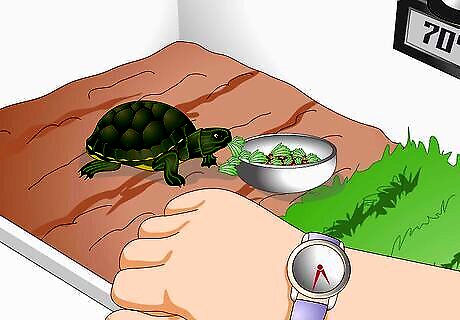
Feed your turtle early in the morning. Turtles tend to be active early in the morning and prefer to eat then. Many turtles will refuse to eat if given food at other times of the day. Try giving your turtle food at 4:30 am or 5:30 am or as close to dawn as possible. In addition to the time of day, you may have to adjust your feeding time based in the season. For example, if you have an outdoor turtle, it may be too cold to eat at dawn during the winter. You may want to give your turtle food a little later in the day in that season. Box turtles also like to eat on rainy mornings because this is when earthworms and slugs are easily found.
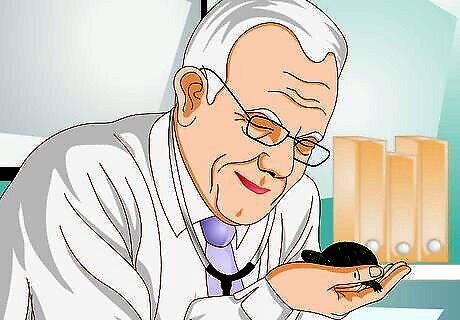
Take your turtle to the veterinarian. If your turtle is not responding to any of he food you offer and the environmental changes, see your veterinarian. Not only could your turtle be fighting an illness, but its health is also at risk when it refuses to eat. Receiving a professional analysis increases the chances of discovering the problem, and a quicker solution eliminates the possibility of your turtle's condition worsening. A herp veterinarian is best equipped to treat your turtle. These veterinarians have received additional training about reptile medicine. If you cannot find a herp veterinarian, contact your local zoo, humane society, or universities (e.g. department of veterinary medicine, animal health science, etc.).
Providing a Healthy Diet
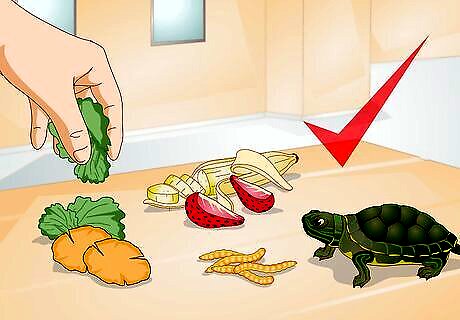
Feed your turtle a balanced diet. Your turtle should eat a balanced diet comprised of fruits, vegetables, and meat. If your turtle is aquatic, its diet should be 65% to 90% meat (e.g. earthworms, snails, mollusks, frozen pinkie mice, dried turtle food/pellets) and 10% to 35% vegetable based (e.g. collard greens, grated carrots, grapes, mango, cantaloupe). If you have a box turtle, its diet should be 50% meat (crickets, mottled mealworms, slugs, snails) and 50% vegetable based (e.g. berries, green beans, winter squash, flower heads). Young turtles need more meat than more mature turtles. These are general rules for turtles, but the diet will vary depending upon the species of your turtle. Always feed your turtle fresh foods.
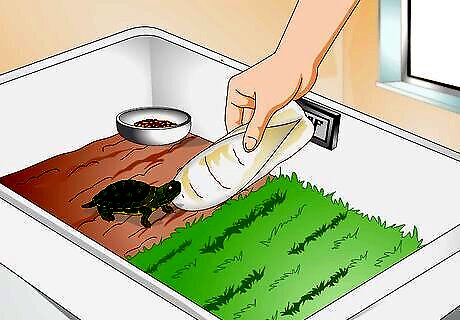
Supplement diet with calcium. Your turtle should get all the vitamins and nutrients it needs if you provide a well-rounded diet. However, most turtles will benefit from calcium supplements. You can supplement calcium by giving your turtle calcium blocks, cuttlefish bone, or powder.> Give your turtle supplements once a week. Place the calcium blocks or cuttlefish bone in your turtle's habitat for you turtles to gnaw on them. You can also coat your turtle's food with calcium powder before you give it to them. You can also give your turtle a reptile or turtle multivitamin twice a week.
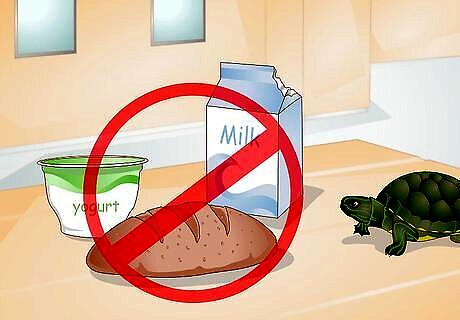
Know which foods to avoid. Your turtle will thrive if given a variety of foods in moderation. However, there are some foods that you should never give your turtle. Avoid the following foods: All milk products (e.g. cheese, yogurt) Candy, chocolate, bread, refined sugar and flour Canned and processed foods high in salt and preservatives Anything in the onions and garlic family Rhubarb Avocado All fruit seeds




















Comments
0 comment